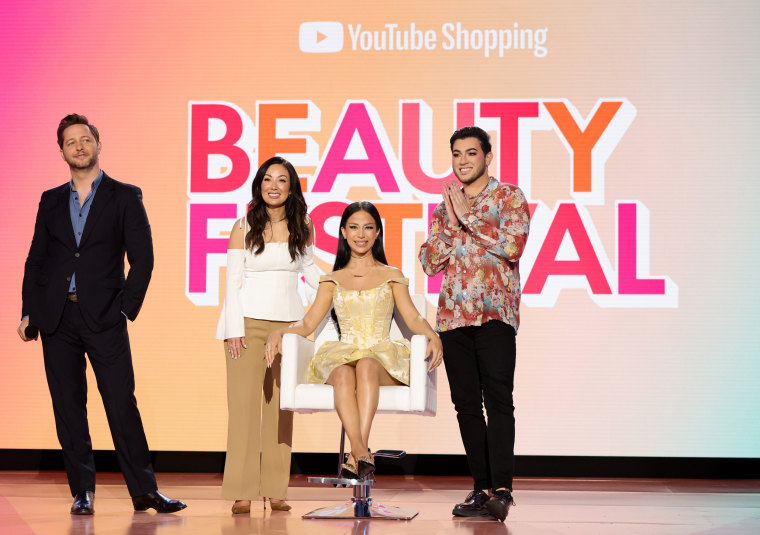YouTube is expanding its live shopping feature, joining other platforms in investing in livestream e-commerce amid mixed results.
The video platform announced Tuesday that it is partnering with Shopify, an e-commerce platform, to launch integrated livestream shopping, a feature that TikTok recently reportedly dropped expansion plans for after it failed to gain traction with consumers.
Live shopping events are like modernized QVC programs, and enable viewers to buy products directly from creator-hosted streamed events.
The Shopify partnership will allow eligible YouTube creators to directly connect their Shopify stores to their profiles, which syncs inventory and enables onsite checkout “so that viewers can complete their purchases without leaving YouTube,” YouTube said in its blog announcing the news.
The expanded shopping features also allows eligible creators — who must have a monetized channel, based in a country where the YouTube Partner Program is available and whose content is not marked “Made for Kids” — to tag their products in livestreams, so that viewers can make purchases without the site.
Live shopping is wildly popular in Asia, where influencers host shoppable livestream events reminiscent of programs once seen on QVC and the Home Shopping Network. Techcrunch reports that Douyin, TikTok’s Chinese counterpart also owned by parent company ByteDance, has tripled live shopping sales over the last year.
But drawing in viewers for live shopping events has proven difficult. Consulting firm McKinsey Digital reported last year that although live events are “highly effective” for creative awareness, they’re less so for “solidifying loyalty.”
“It’s worth noting that many impulse shoppers are one-time buyers, so a newly attracted audience can’t be taken for granted,” the report said. “Keeping it will take work.”
Instagram promoted a similar feature last year during a 10-day live shopping series, while Amazon has reportedly offered creators thousands of dollars in bonuses to use its own platform instead of streaming on others. TikTok’s sister app Douyin has seen considerable success around live shopping in Asia, but the platform struggled to make sales goals when it rolled out the feature in Europe last year.
Earlier this year TikTok abandoned efforts to expand “TikTok Shop,” which launched in the United Kingdom last year and allowed viewers to directly buy the products advertised in creator livestreams. But U.K.-based livestream events were plagued with low sales and sparse attendance, the Financial Times reported.
YouTube hinted at its new shopping features during its second annual BeautyFest in June, a florid shoppable event streamed from a soundstage at YouTube Space in Playa Vista, Calif. Unlike last year’s event, the sophomore BeautyFest was live.
Arms stacked with bags of sample products, beauty and fashion creators packed into decorated booths for demonstrations from Rihanna’s Fenty Beauty and makeup guru Jackie Aina’s FORVR candles. Some dodged camera equipment and production crew members, who weaved between the crowd to film segments at the main stage and individual booths.
The event was nothing short of spectacular, opening with an appearance from Tracy Ellis Ross, who took an on-stage shower to show off her Pattern hair care line. Safiya Nygaard, the YouTuber known for her “Bad Makeup Science” series, tried out a hairdryer bag in a pre-recorded segment, and makeup vlogger Manny MUA tested his Lunar Beauty cosmetics on creator Amber Scholl live on stage. Family vlogger Catherine McBroom, who was sued last year for allegedly attempting to stage a coup of 1212 Gateway, the skincare brand she represented, joined BeautyFest to advertise the same brand’s body oil.
Between product demonstrations for various elixirs and interviews with creators turned entrepreneurs, Blasberg repeatedly reminded viewers that with just a click, they could purchase the products live during the show.
The less amount of clicks to get them to buy, the better
Chris Vaccarino, founder and CEO of the merchandise company Fanjoy
“By allowing the viewer to shop directly from YouTube, it makes shopping seamless and easy,” Blogliates creator and Shopify merchant Cassey Ho said in YouTube’s announcement. “I predict that this will heavily impact my conversion rate, which will help more people give my products and my brand a chance to become part of their everyday life!”
An online store’s conversion rate is the percentage of visitors who actually bought something.
Chris Vaccarino, founder and CEO of the merchandise company Fanjoy, predicts that live shopping will be the future of e-commerce because it minimizes steps potential buyers have to take.
Instagram, he said, has excelled in integrated shopping.
“Getting someone to take action is harder, because you have to go to the bio, click the link and then kind of click out,” Vaccarino said. “The less amount of clicks to get them to buy, the better.”
In November 2021, when YouTube kicked off its YouTube Holiday Stream & Shop, the platform said in its blog that what’s been clear to them is that “people want to shop on YouTube.” In a YouTube study conducted in partnership with Publicis and TalkShoppe, “89% of viewers agree that YouTube creators give recommendations they can trust. We can make it easier to shop by integrating it directly into YouTube, removing steps in this process, and making the entire shopping experience fun and interactive for our users.”
YouTube appears to remain optimistic that its livestreams will be the future of online shopping.
“We believe that creators are the next generation of merchants,” Shopify VP of Product said in the announcement. “And YouTube has been a long-time leader in powering this new cohort of entrepreneurs.”
